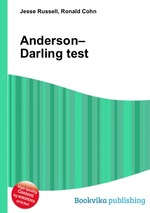Anderson–Darling test
Jesse Russell Ronald Cohn
бумажная книга
High Quality Content by WIKIPEDIA articles! In statistics, the Anderson–Darling test, named after Theodore Wilbur Anderson (born 1918) and Donald A. Darling (born 1915), who invented it in 1952, is a statistical test of whether there is evidence that a given sample of data did not arise from a given probability distribution. In its basic form, the test assumes that there are no parameters to be estimated in the distribution being tested, in which case the test and its set of critical values is distribution-free. However, the test is most often used in contexts where a family of distributions is being tested, in which case the parameters of that family need to be estimated and account must be taken of this in adjusting either the test-statistic or its critical values.


